ED WRIGHT: Composer
6/4/13I have finally dragged myself into the 21st century. The code for a lot of my work is now up at https://github.com/edwardwright/virtual440
3/4/13
Please excercise caution if you decide to buy this book. I am very flattered that people have lifted things to do with my life from Wikipedia but it is NOT worth buying. The information is all up there on-line. If you buy this they will be ripping down my reputation and your bank balance... Sorry :(
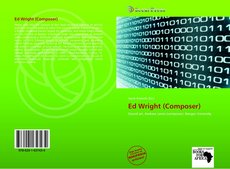
DROP! Interactive sound game, Ed Wright 2013.
The music is a mix of 11 short audio extracts. These range from close microphone recordings of marbles doing things in the studio; such as rattling in a bowl, or going down the marble run. One percussive sound has been made by taking the sound of a marble and drooping it on a board, slowing it down four times and then modelling the reverberant acoustic of York Minster around it. Other sounds are more mainstream ranging from FM synthesis (the default setting for all good sci-fi film scores!) as well as a more dance-y sounding loop created in Reactor.
The audio was balanced an mixed in 4channel surround sound to enhance the motion and movement of the tracks. The sounds of a bicycle bell and a duck have been thrown in for good measure.
Things happen in the work when the marble rolls over two pieces of aluminium tape and completes a circuit, effectively closing a switch. With the aid of some home made electronics and an Arduino circuit board-chip housed in an old Chinese takeaway box these messages are sent via USB, luck and faery power, to the computer.
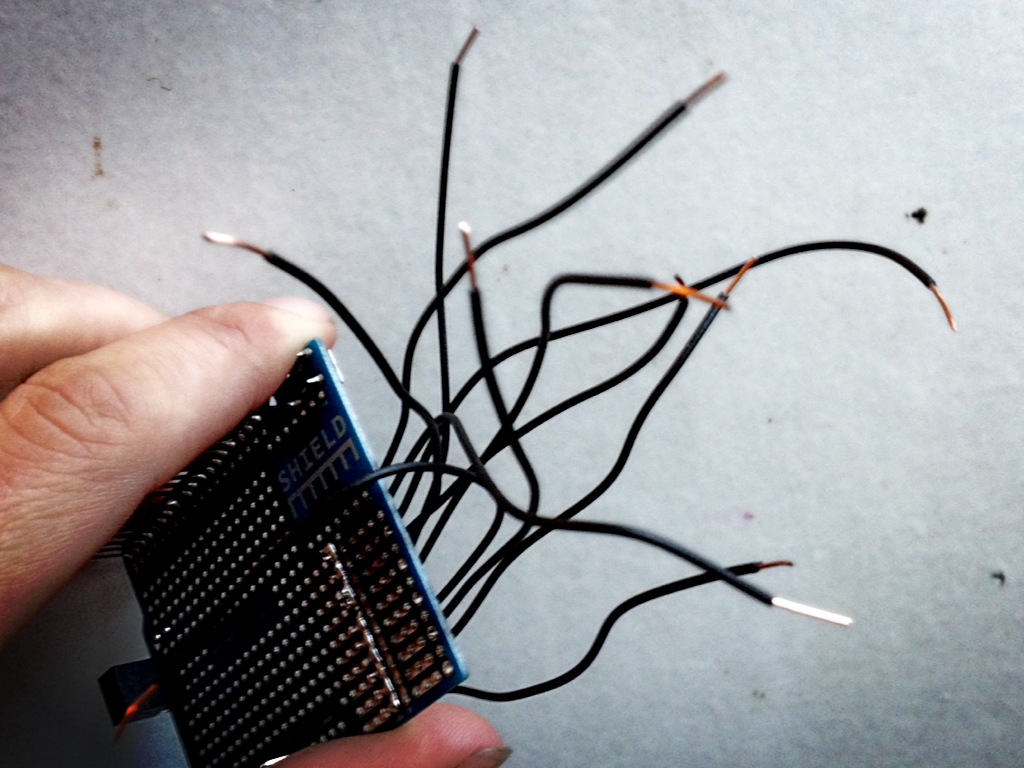
In the computer the interface which de-codes all these signals, brings up pictures of the active part of the marble run and plays back the audio has been written in Max MSP. Hopefully that makes sense for those that want it to, the full code is available here.
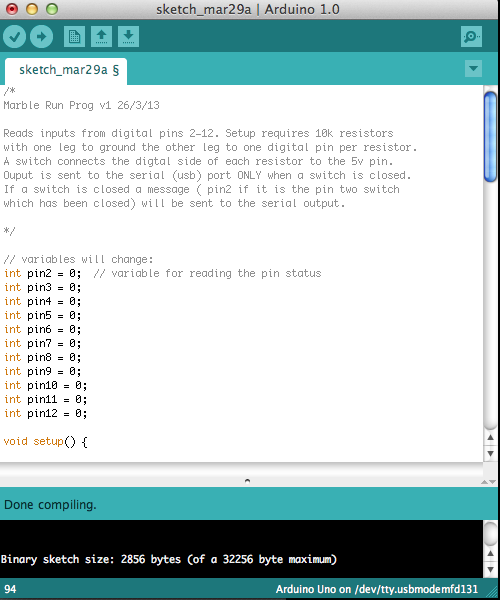
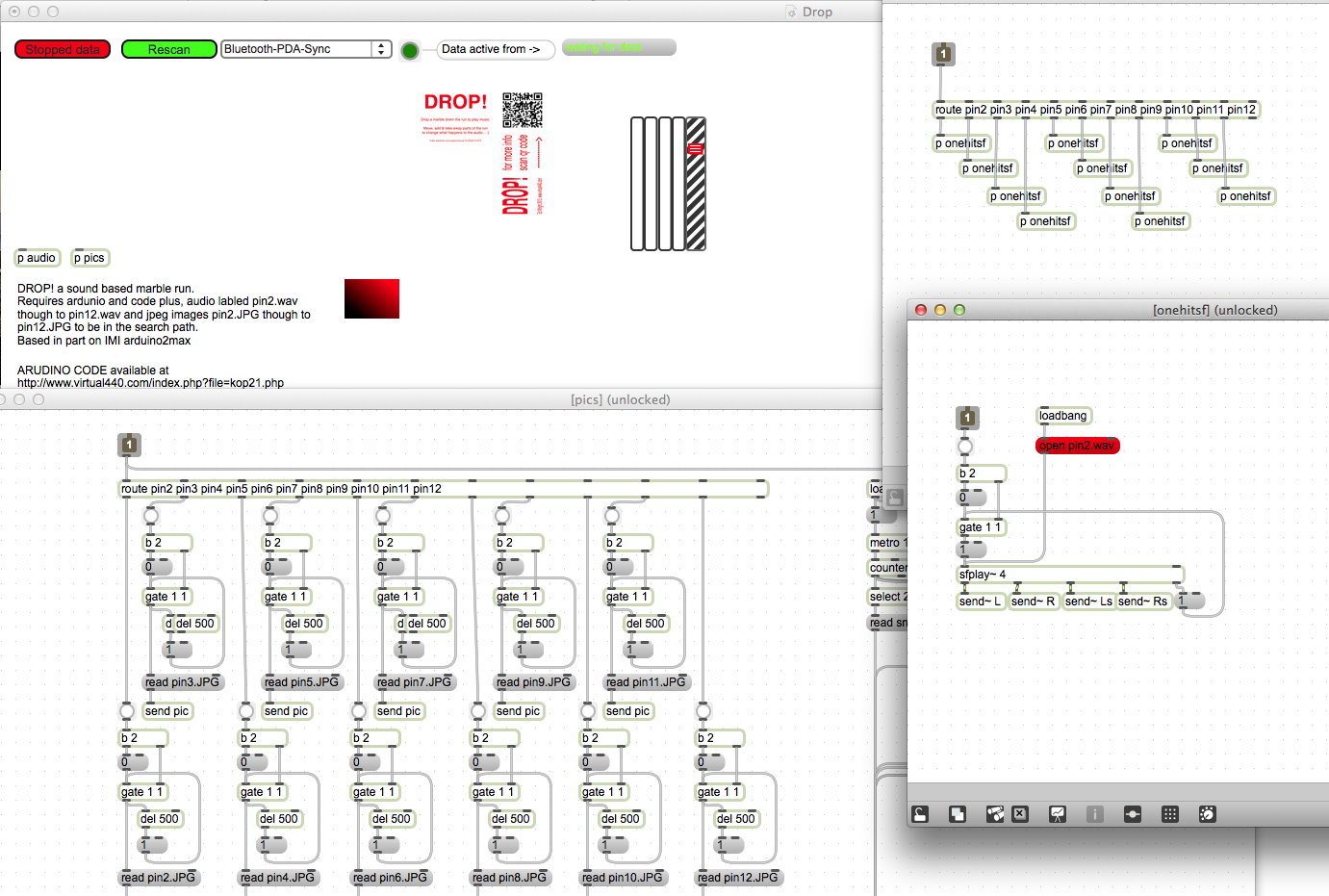
Many thanks to Alena Grace Wright for her assistance and forebearance with this project.
23/3/13Today I've been at code control in Leicester, good to catch up with the gang such as Andrew Hill & Richard Garrett. Roughly 5 years ago to the day I delivered my first paper at SSSP DeMonfort Uni here. I was due to become a Dad pretty much on the day and in true biblical style we trekked over here. It would have been one hell of a 'keynote snub' but didn't happen until a few days later!
Due to the stupid amount of un-seasonal snow the zip of my Mammut winter jacket (and the rest of it!) has finally broken. New coat, a visit to a dead monarch... and yes Richard iii's carpark is very pretty as car parks go. Gig tomorrow/today, good night all
5/3/13
Going out recording source sound objects with 21 year 6 pupils from Ysgol y Graig Llangefni for Bangor New Music Festival. The sun is out, the grass is green, let the madness commence!
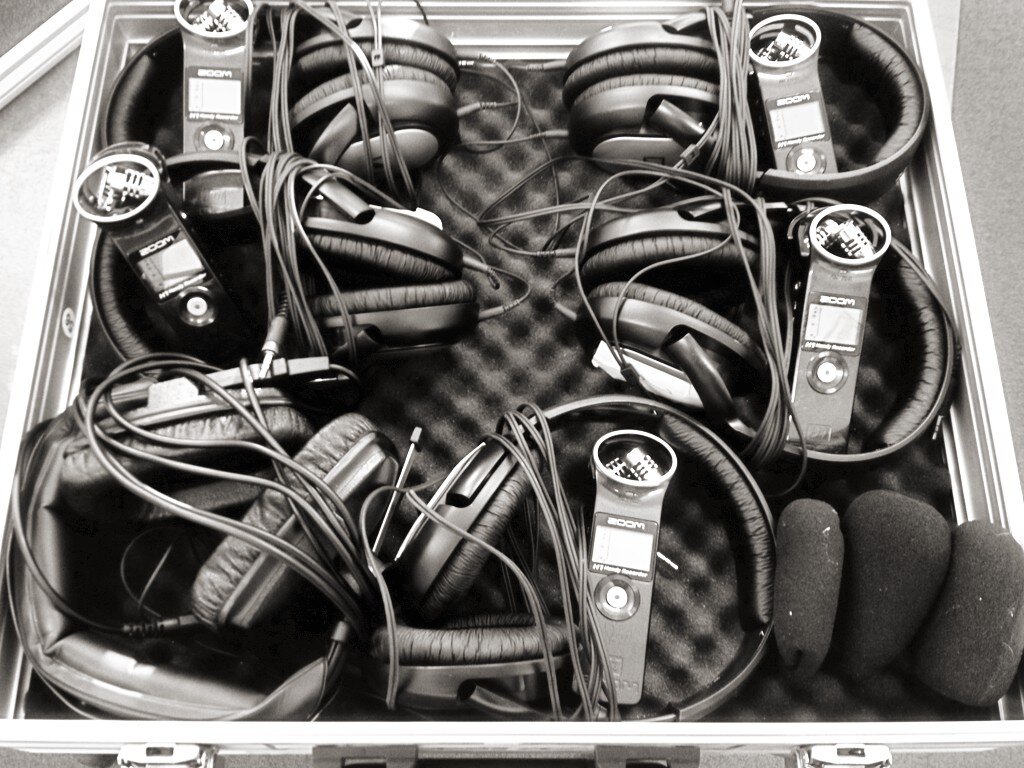
12/2/13
RIP Dr. David Evans
A sad day, the loss of a teacher, friend, fantastic story teller and an encyclopaedic mind. A truly gentle and generous soul. Thank you David.
1/2/13
Having fun recording a game of snakes and ladders in 6 channel surround sound. I am very greatful to Alena for letting me use the wooden game set that Granny and Grandad gave her for Christmas, and for Mik's help in setting up, playing, de-rigging and being up for madness!
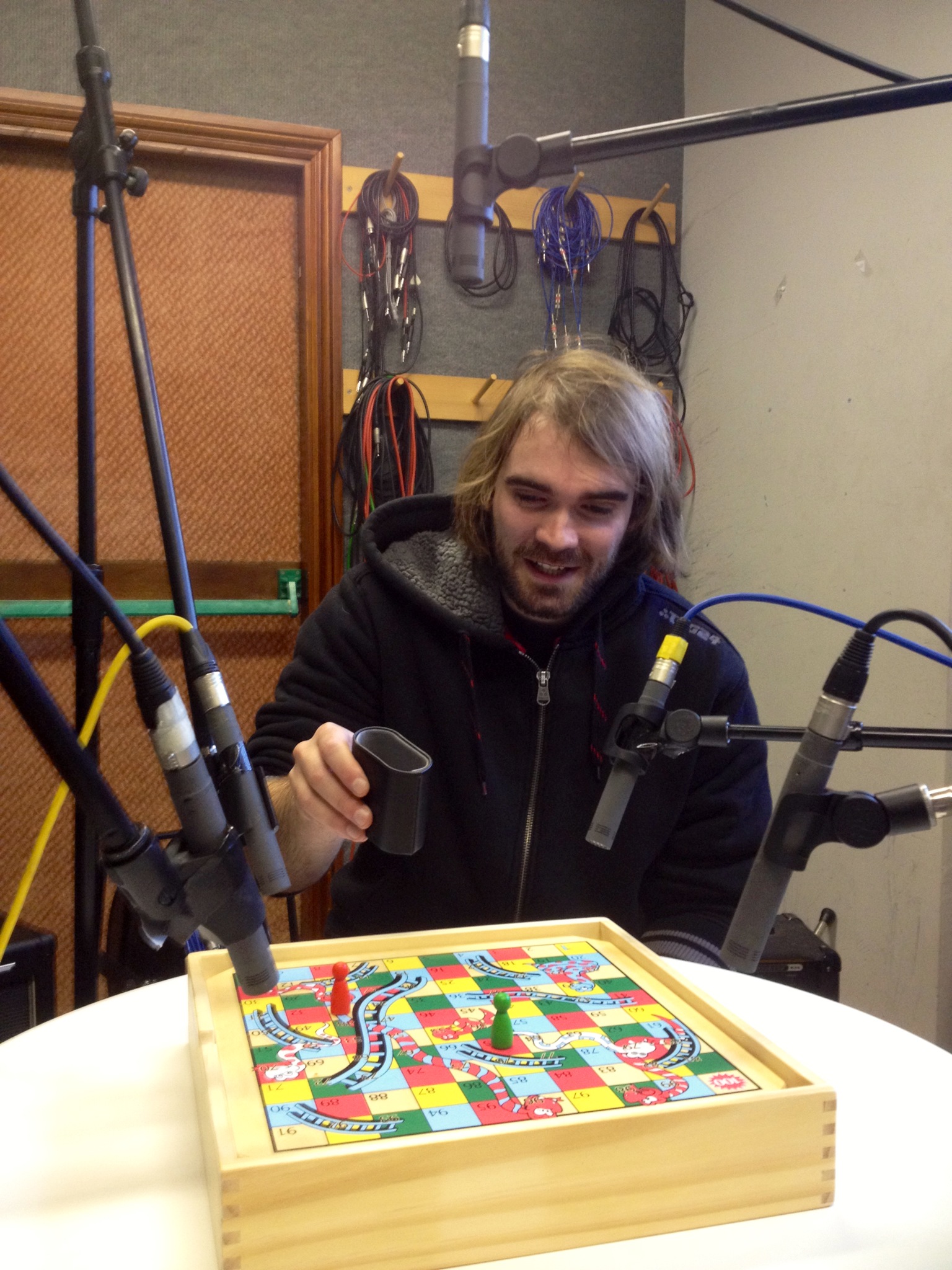
20/12/12
Happy Christmas and New Year to all those who celebrate such things, and tons of love to those who don’t. It’s the end of a long year, hopefully the world will not end tomorrow! I have been seriously lucky this year and have had reason to travel to: London, Leeds, Edinburgh, Ljubljana and Toronto to name but a few. I’ve played about making seascape installations, played the violin, diffused acousmatic works, been exhibited in galleries, taught and learned a hell of a lot more. Thanks to all that have helped, listened, watched, (those who’ve read how I’ve staggered on through this blog) put up with, and even to those who’ve been down right hostile, it’s been a blast. Good luck for Christmas, the New Year and the end of the world tomorrow. :)
18/12/12
First steps in proper Sonification.... Here we go with one I made earlier!
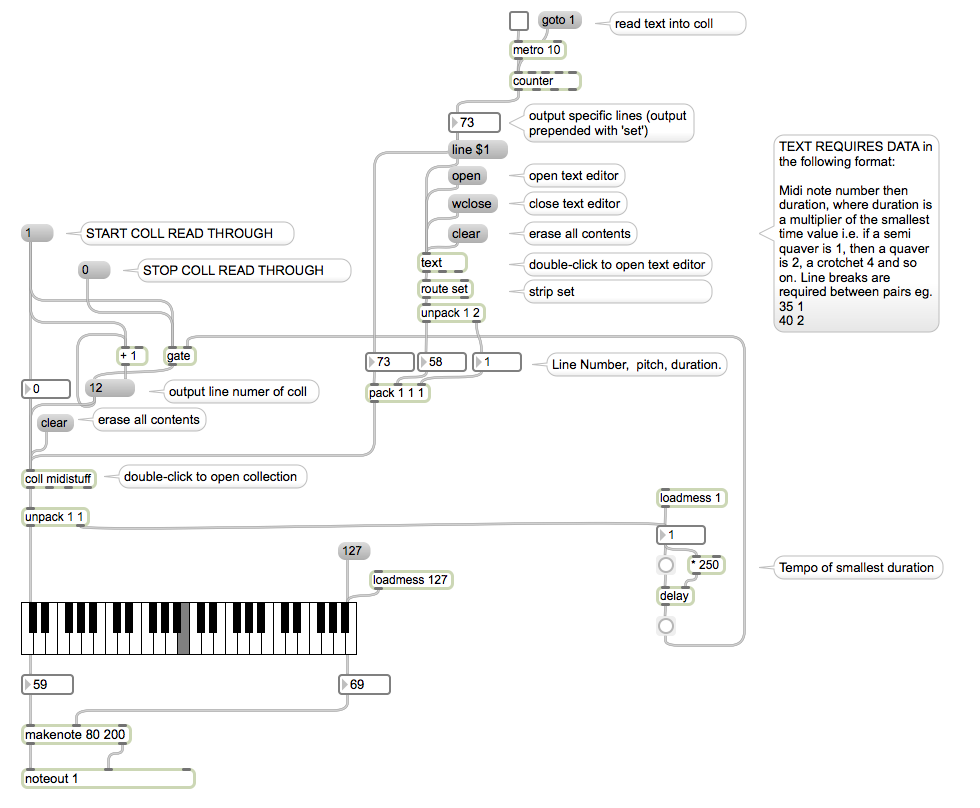
11/12/12
Revving up for random family Christmas carols! Nice to see the spirit of wonder about the inside of a piano still carries on!
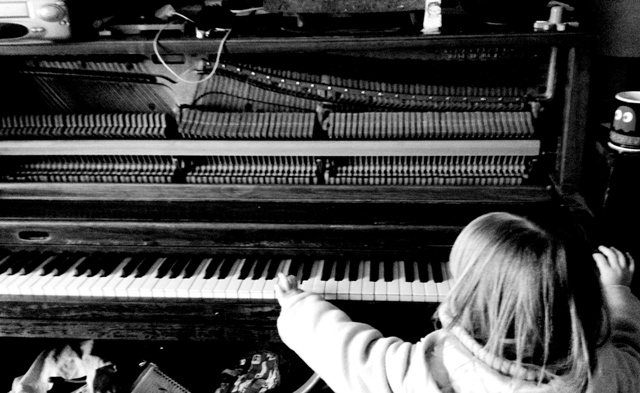
26/11/12
Dear All, I don't think I have ever put up a concert on here that I am not playing in, but this is one that I am helping to set up for in Bangor and by a man who I have amazing amounts of respect for, both as a person, for the fanatical precision that goes into his work and a great sense of humour. So come along if you can!
ElectroacousticWALES
Trevor Wishart: © R.H.Y. Yau / 23five Incorporated
Andrew Lewis (director)
Renowned English composer Trevor Wishart presents his newest work Encounters in the Republic of Heaven, an invisible ‘sonic opera’ in which recordings of everyday stories told by adults and children from north-east England are computer-transformed into a fantastic surround-sound experience.
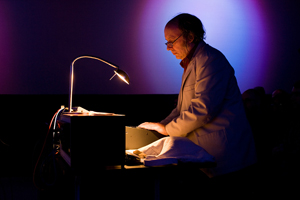
Tickets: £10 full price; £7 concessions; £5 students. One child admitted free with every accompanying adult. Additional children £2.
Date: 29/11/2012
Time: 08:00:00 PM
Location: Powis Hall, Main Arts Building, Bangor University LL57 2DG
For more info click here
23/11/12
After the rain, floods and high winds of yesterday, yhis is the road outside Hendre Hall where my studio is.
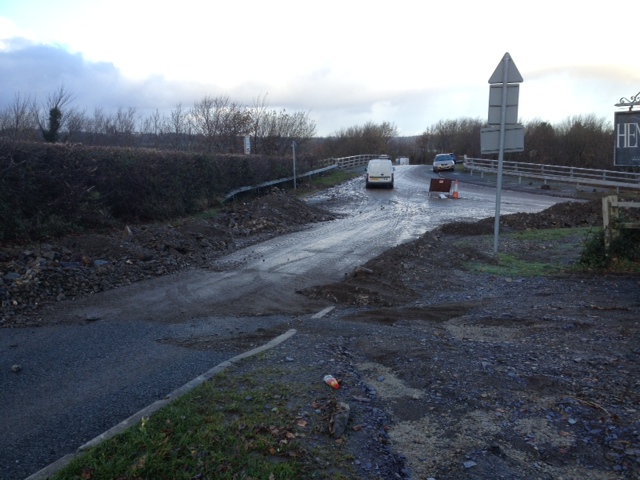
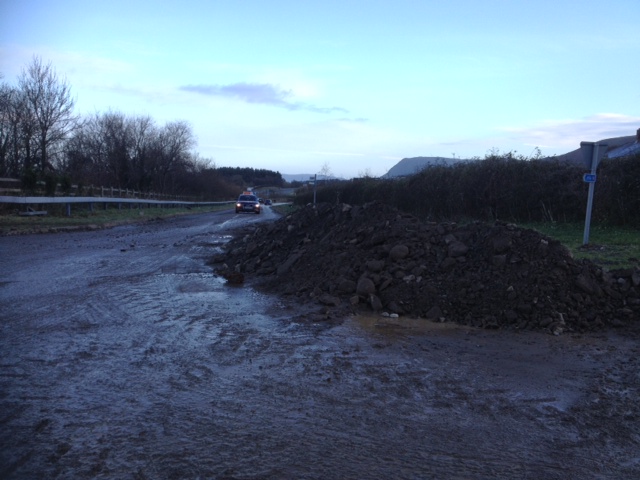
Given the size of the boulders (no exageration) washed down the hill and the 2 ft of mud that has drifted onto the side of the road I am amazed that the water didn't get into the studio. Sometimes having to carry stuff up steps can be a blessing after all. My thoughts and sympathies go out to all affected by the weather of the last few days, and with more to come, keep safe.
31/10/12
Still pushing forward, proud to be playing for this back in Bangor with a load of friends, and a super-sexy poster!
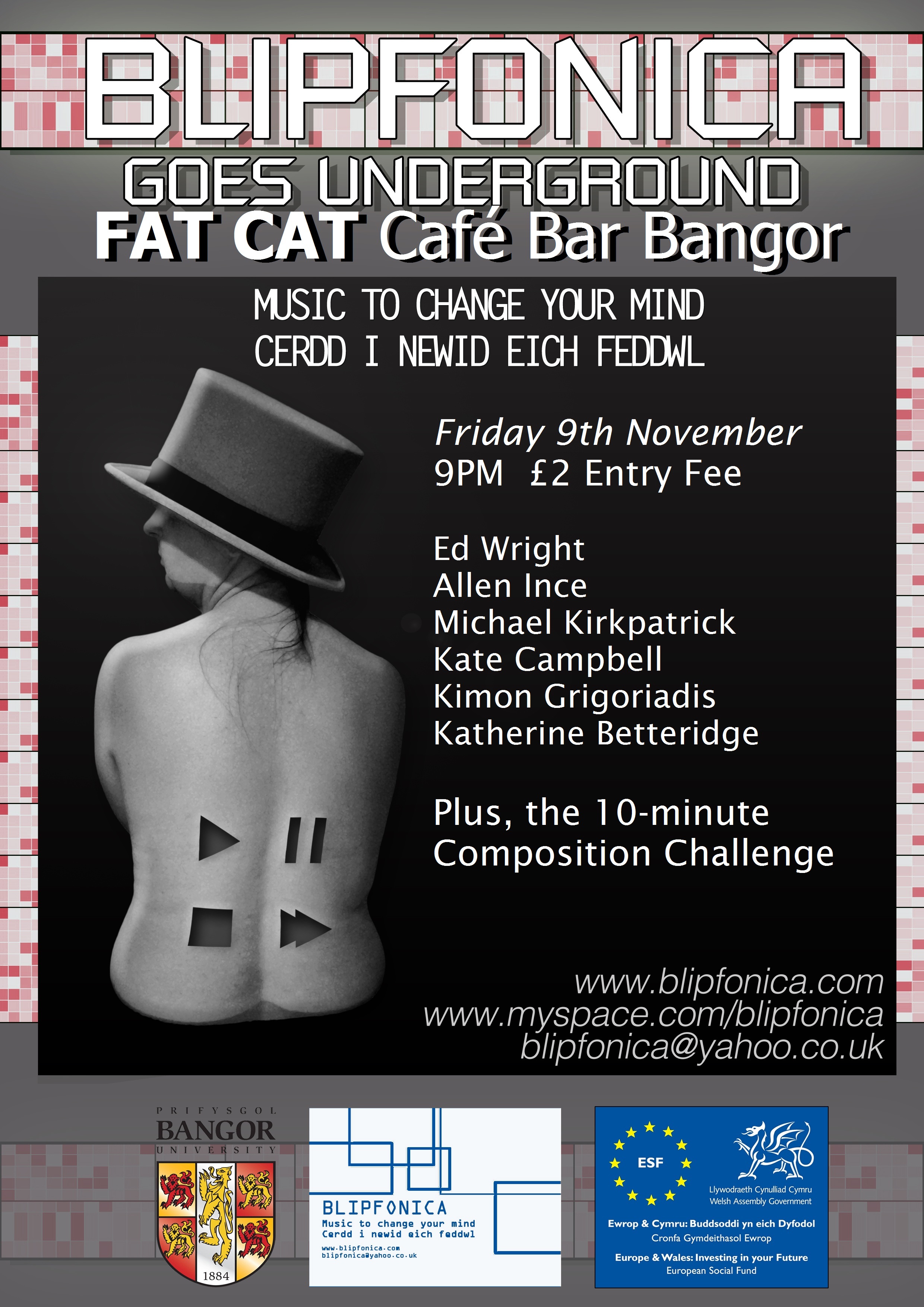
2/10/12
Back to lecturing, it seems we have a very nice bunch of students and it is quite refreshing to be teaching on ways to use stuff such as Max/MSP rather than just how to use it! :)
20/9/12
On return to the U.K. it seems the entire world has a cold, oh dear, here we go!
12/9/12
In Ljubljana for ICMC 2012, beautiful city crappy hostel, but it does have internet access and therefore the not quite qwerty (qwertz) keyboards have brilliant 'new' letter keys!
ćčžšćčžšćžčšžćčšžžžćšššćžććščŁkłllllŁŁŁŁłłłłłłßßßßžžžž˘˘^ˇ
Ok I'll stop now.
28/8/12
Taking a moment out from writing to watch stuff that has been sent to me. Thanks to Andrew Hill for the link to this and to John Richards and the Dirty Electronics crowd. Its a really nice little portrait of what they do and the overall feel of what goes on. It's not overly techy which is probably both a good and a bad thing but, they are lovely people and I've stuck it up here so that hopefully a few more people can get to see their work too!
Charge/Discharge (2012) by John Richards [Documentary & Performance] from Andrew Hill on Vimeo.
20/8/12
Back from Toronto, what a lovely place and people, if they had tea it would be even better! Now hiding re-grouping and getting set for ICMC!
15/8/12
Playing violin for a symposium in Toronto whilst staying in a backpacking hostel, whatever I do I seem to always be massively under/over dressed!
13/8/12
Sorting out last odds and ends to fly to Canada in the morning. This will be my first ever trans-Atlantic flight, super excited! It's for this...
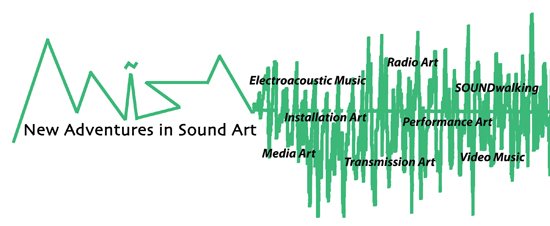
Toronto Electroacoustic Symposium 2012
New Adventures in Sound Art (NAISA) and The Canadian Electroacoustic Community (CEC) are pleased to announce the 6th annual Toronto Electroacoustic Symposium 2012. At the heart of this 6th annual symposium will be a keynote lecture by Sound Travels featured artist Trevor Wishart (UK).
All events at the Artscape Wychwood Barns, 601 Christie St in the Christie Studio (#170)
except evening concerts which are in the Wychwood Theatre (#176)
Kerry Hagan - Morphons and Bions
Ethan Hayden - bats with baby faces in the violet light
Yota Kobayashi -Shikisou
Donna Hewitt - One
Ed Wright - Crosswire
Andrew Connor - No. 3: Foghorn Abstraction
http://www.naisa.ca/soundtravels/symposium.html
1/8/12
Having battled my way along the coast via car, foot, train and bicycle I'm now in the process of mixing down for ICMC in Slovenia yeeeeehaaaa!
For more details and program see http://www.icmc2012.si/program.html
23/7/12
Here's some footage of a piece by Richard Worth entitled Green Man Blue that uses some programming I put together for the electronics. Enjoy!
25/6/12
Recovering... and gearing up for next weekend! It was nice to see my parents though this weekend :)
19/6/12
Gearing up for a mad one... Running and performing in Risk of Shock in Bangor (N. Wales) on Thursday evening, then throwing a load of kit in the car and driving down to do stuff at BEAM Festival at Uxbridge (London) Friday - Sunday.... Wish me luck!
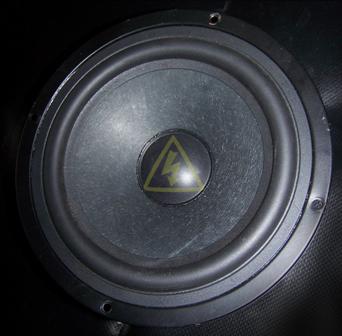
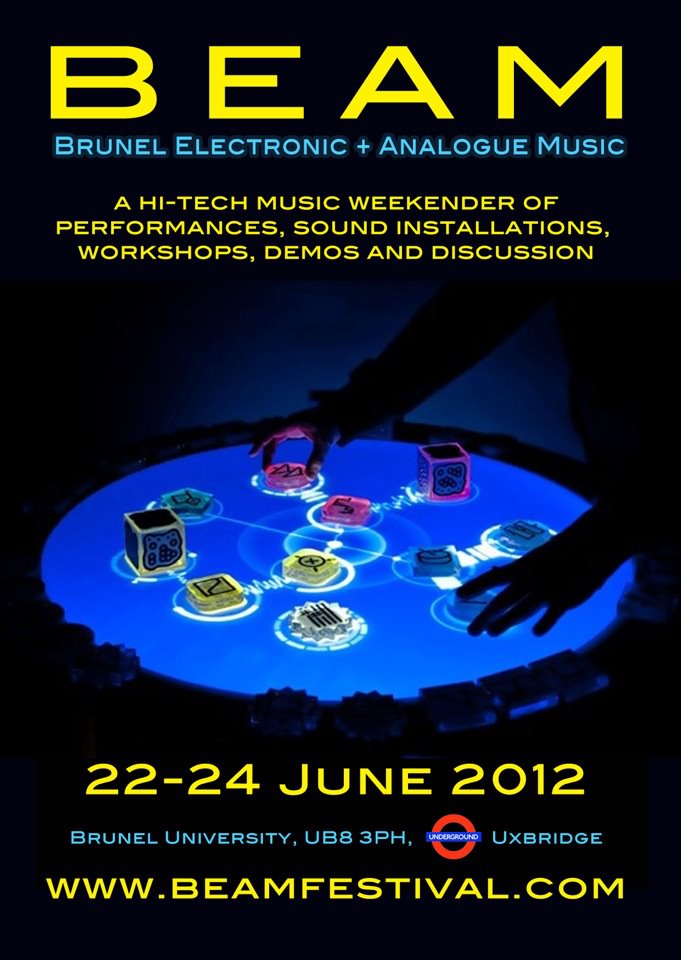
24/5/12
WOOOOOOOO! Got through to both Toronto Electroacoustic Symposium AND ICMC2012. A little giddy right now! And thankful to Prof. Thomas for helping to fins a bit of cash to cover travel!!!
2/5/12
Just discovered this flyer, you can just make out 'Crosswire' on there, yep that's me in Edinburgh this time next week! :)
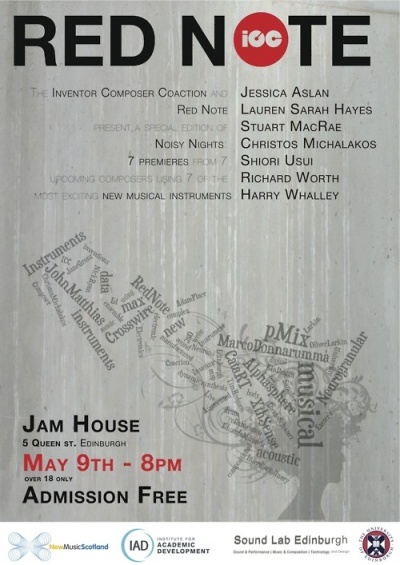
27/4/12
Playing at IFIMPAC at Leeds College of Music.
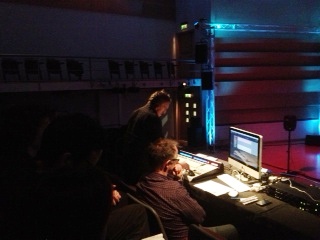
A great few days! Blogging on the train home, stuck at Manchester Piccadilly waiting for the train to Chester. It's now 11:15 on Friday, I got to sleep around 3 am thurs, up at 5:30, bed last night at 2am gigged today and wont be home till gone 2pm Sat..... IF THE TRAINS ALL MAKE THEIR CONNECTIONS!!! Listening to Sqarepusher Ultravisitor as a come down to chill out and show my age. Nos da pawb;)
27/4/12
In Leeds waiting to rehearse...
25/4/12 cont.
Also gearing up for Ifimpac in Leeds tomorrow. Lots of work to do on the train...
http://postgraduate.lcm.ac.uk/leeds-international-festival-innovations-music-production-and-composition
25/4/12
Proper geek moment.... Is it wrong to get excited when someone else tweets a picture of them running your software several hundred miles away? Oh well guess it’s just me being sad then, but hey, Richard Worth and the Red Note Ensemble are currently working on a piece of his based on my Crosswire software to be performed in Edinburgh next month.
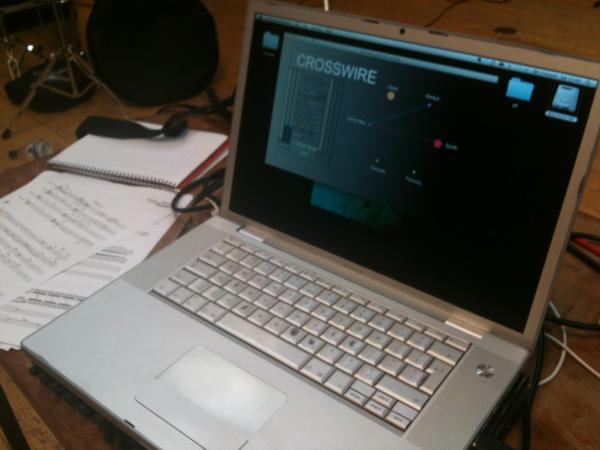
http://www.inventorcomposer.net/
Noisy Nights with ICC
When Wed, May 9, 20:00 – 22:00
Where The Jam House, Queen St, Edinburgh
Description Over 30 expert designers from around the world have contributed a variety of instruments, interfaces and sound generators for the seven resident composers from the University of Edinburgh to work with. These range from 3D-printed spheres that respond to touch, to software modelled on neurons firing inside a human brain. The composers will create chamber works written specifically for their chosen instrument, to be performed by Red Note at a special edition of Noisy Nights at The Jam House, 5 Queen Street, Edinburgh at 8pm on Wednesday 9 May.
18/4/12
Spent most of today preparing 2 lectures; one on logic and it's written form' the other on interfacing Arduino boards with Max/msp. I wonder how much I'll remember tomorrow?!
12/4/12
Very happy, to be being part of this. Congratulations to all the artists and organisers for a wonderful few days!
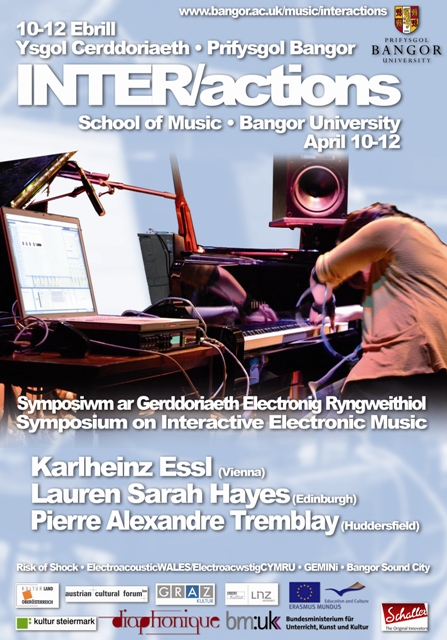
31/3/12
Hello all, sorry for not being here for a while. It has been frantically busy with the Bangor New Music Festival, Y Galeri Caernarfon, Cauldrons and Furnaces, and Interactions to name but a few! Anyway, trying to stay focused and also relaxed, so if you see me running around like a fool please, you have my written permission, tell me to calm down!
3/3/12
My piece Con-chords is playing today, almost yesterday/tomorrow given time differences as part of W.E.A.L.R. (World ElectroAcoustic Listening Room) an element of California State Universitys' New Music Festival. Drop in if you can! See EVENTS for more details.
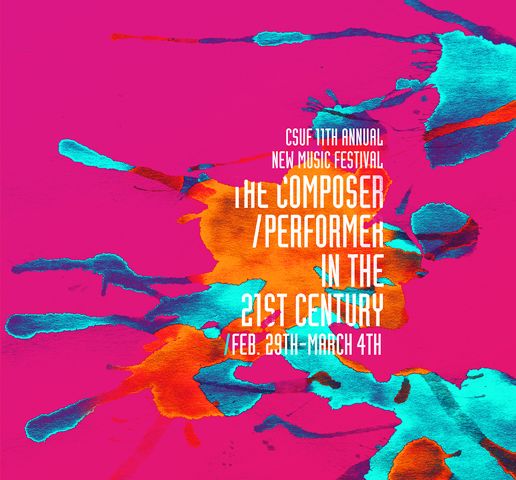
22/2/12
Amazing moment! I ran the Who Can Hear the Sea? installation in the studio overnight. Wonderful to walk back in to find that, firstly it hadn't crashed, and, it actually worked. The different loops are all re-triggering correctly and therefore the sounds are continuously shifting in time. It's like an entirely new piece this morning. YES!
21/2/12
One piece finished... time for pancakes!
16/2/12
Nearing completion with Who Can Hear The Sea? I've had to build a player to make the looping stuff work and realised that it may have 'normal' people looking at it so decided I really should make it pretty! 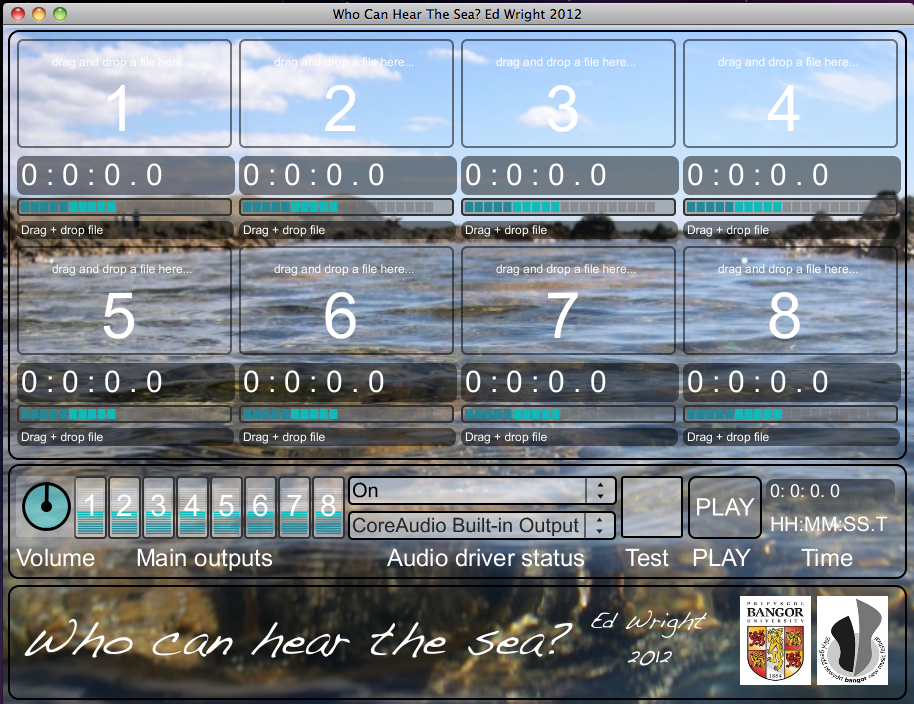
6/2/12 - cont.
Complete Bricks, and Parties
I have spent the evening working on Who Can Hear the Sea. There is something there now, I’m not sure what, it still needs a lot of refining but it is growing into being a useful installation piece. To keep the work open and moving it is based around the idea of 8 surround sound audio loops running at once with sound objects/musical gestures on each of them. The trick is that when each loop gets to the end it simply starts again, but no two loops are quite the same length. The loops last for:
401, 397, 389, 383, 379, 373, 367 & 359 seconds.
All of these figures by my reckoning are prime numbers. Once the piece has been started it will take around 1800 years for it to all come back into sync. This is all well and good and fits with the idea of water and the image it is never the same even though it may be the same stretch of water.
From a musical and composing point of view making this work is becoming more interesting. In order to retain much musical sense, at some level each loop must be self contained. As the loops become staggered the different elements of composite sounds will obviously go out of sync, therefore to create a piece that does not simply sound out of sync there must be complete musical gestures contained within each loop. Obviously these can interact with other loops much like phasing in minimalism or fugue and countersubject, but in much the same way there needs to be completeness to each element.
Moving up from this level we get into context and causality, trying to introduce the various elements and gestures in a self contained way. Rather like going to a party and having to introduce yourself to everyone, it is hard to get a system to introduce itself: firstly at all (how do you prepare for something with that something?) and then how to achieve this without becoming oddly repetitive (Hello I’m X and I work in Y, how are you? Have you met Z?)
Once this hull is breached how does one create structure?
I am placing faith in two apparently contradictory points of view. Firstly the minimalism/fugue analogy, in this work is at some level very similar in that there are complex elements arranged within a very strict (if somewhat less apparent) time structure. Secondly, that I am emulating the stretch of water image. Once this is realised the rest falls into place. Perhaps I am not creating ‘musical’ structure but rather a different, time based structure on which I am hanging various sonic artefacts that help the listener to navigate through it by mapping time, the relationships of the cyclical loops and augmenting the aesthetic experience of this passage of time and memory.
Just a thought. Night night all!
6/2/12
Working towards this:
28/1/12
I have a poorly dog and a tax return to do :(
25/1/12
Lots of marking, lecturing and running of open mic night, hard work paying off though, got listed for icc http://people.ace.ed.ac.uk/students/s9809024/icc/crosswire.htm

24/1/12
Setting up for a long one in Studio 1 Bangor Uni tonight!

16/1/12
can now blog via mobile...
11/1/12
Just been appointed 'Teaching Fellow in Music' at Bangor University. Ooooooh
9/1/12
Happily processing sea sound to make new sound objects :)
3/1/12
New work in the pipeline to be premiered 10/3/12 at Bangor New Music Festival.
Who Can Hear The Sea?
Sound Installation for: Surround sound audio and max/msp programming.
Who Can Hear The Sea? is a sound installation commissioned by the Bangor New Music Festival. The sea is a major theme of this year’s festival as well as being a fascinating subject for recording. In developing this piece I tried to record the sound of the sea, free from outside influences such as: wind, road noise and sea gulls, but gradually became aware of a number of issues that arise.
Beside the practical issues of trying to find a silent beach on a windless day, with big waves, water by itself makes little or no noise; it is the matter and energy around it, in it, acting on it and contained in it that makes it sonorous. In addition to this there is the dynamic but structured nature of the sea, it is constantly changing, in an incredibly complex, yet ordered way.
Who Can Hear The Sea? Uses recordings of sea waves as its basis and then uses computer processing and techniques such as subtractive synthesis to shape confine and restrict these sounds to create a number of sonic objects or ‘musical’ statements.
These sound objects have then been edited together to create 8 audio loops, the longest of which is 7’02” and the shortest of which is 5’59”. These loops all play simultaneously and repeat as they reach the end of each play through. Thus the different loops move in and out of phase. Not only does this make for a constantly changing piece, it means that just like the sea you can listen to it and hear ongoing similarities but it will never be quite the same again; as for all the loops to come back to the start and line up exactly it would take 1875 years, 1 day, and 16 seconds (roughly)!
31/12/11
Happy New Year (and late Christmas!) to all! Best wishes to those who don't subscribe to the same calendar as I do too! I hope the next 12 months will be even better than the last and that everyone gets what they need, even if not all that they want. Take care.
7/12/11
Starting work on a new sound installation commission for Bangor New Music Festival, to be premiered 10/3/2012, based (loosely) around the theme of the sea. XD
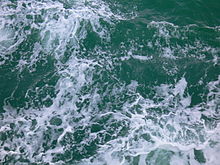
7/12/11
Over the last few days I've been thinking about composition and analysing what it is we do, how I want to do it and attempting to clarify my thoughts. So. Here goes....
This is where I am coming from and the direction in which I want to travel.
|
Manifesto 5 Dec 2011 1. I want to create works utilising sound; for the development and creation of artistic, aesthetic, moral and philosophical structures. 2. These will aim to be of high quality. 3. Where possible the technology used or developed will be open source and carry the potential for reverse engineering. 4. The output will be accessible to listeners, performers and other composers; in terms of performances, materials and syntax. 5. The works must be artistically and economically sustainable. Ed Wright |
29/11/11
Very horrible and rainy out there so have tried to compile a load of program notes click here to see them! PROGRAM NOTES
10/11/11
A couple of videos from the Blipfonica Live concert last weekend.
If you can't view them here try http://www.youtube.com/user/edwright440
10/11/11
Played my first public event ever on the Theremin last night. Wooop woop!
6/11/11
Going into hibernation as far as new works go for a while. There are several gigs coming up and lots of things I'm working on behind the scenes, but for once there is no instant deadline for a new piece coming up. Several new pieces are in the pipeline and will be unleashed soon. I'm off to the shed with a new set of violin strings and a theremin, 'dum de dum'.
24/10/11
Wendy Dawsons' recording of the projection of Amser/Time by Tim Pugh Wendy Dawson and Ed Wright on the side of Conwy castle for Blinc Festival on Saturday night. We could give you the glossy studio version but you'd miss the mad and massive atmosphere there. Current estimates put it at 1500 people on the Quay alone!
20/10/11
Well done to all at Risk of Shock! And yes I will take the School of Music kettle back!
Photo of me in mid scribble performing 'Live Study' taken by Huw Williams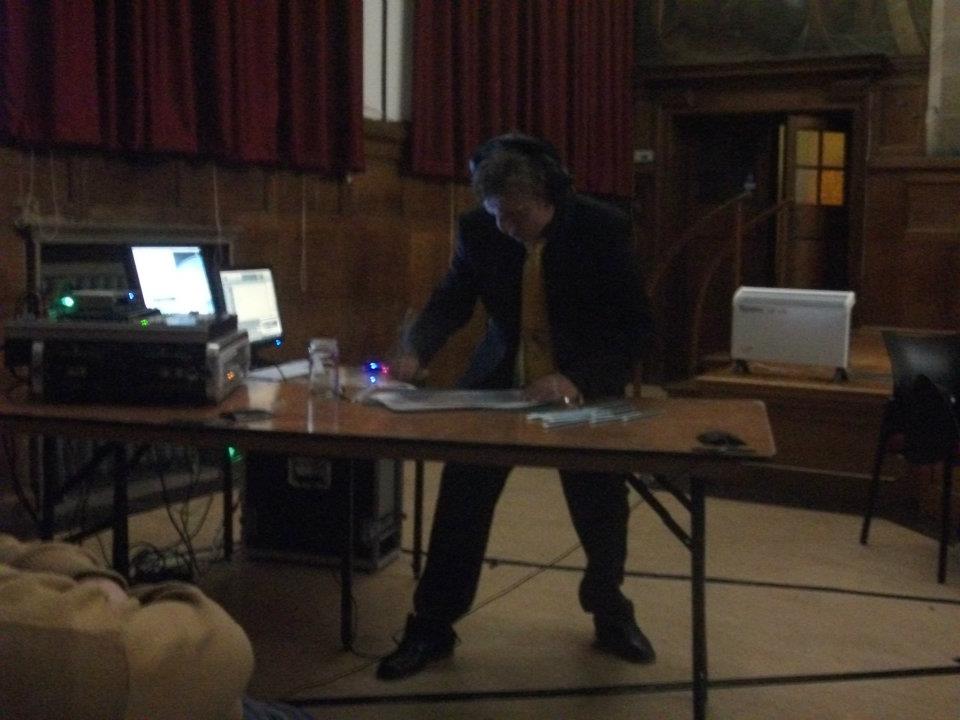
19/10/11
Running around like a loon trying to sort out for three days of events; Risk of Shock and Blinc (see EVENTS for further info. But it turns out I'm not the only one as Joel's photo below will prove. This shows a roof, yes a roof, being put on top of one of the towers in the town walls of Conwy in order to house 'This is Tomorrow' Dominic McGill's sculpture and my audio. 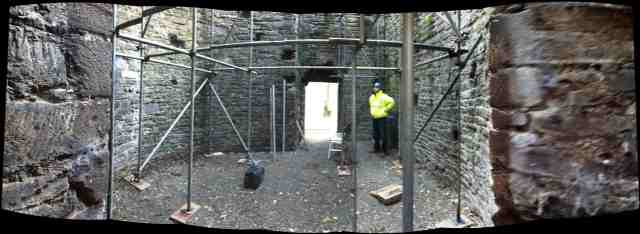
This is basically civil engineering in a world heritage site! Feeling a little humble right now. And yes, it will be taken down after!
Great to be part of so many good teams for the upcoming days. Bangor Uni, Blinc and Blipfonica, thank you. And also anyone else who should have been on the list, even if you didn't begin with 'B'.
Risk of Shock - Powis Hall Bangor Fri 7:30pm
Blinc - Conwy sat-sun all day.
***All free!***
17/10/11
A wonderful sketch by Dominic mapping out the text and Moebuis patterning of the audio for 'This is Tomorrow' I'm not quite sure if he did it before or after I played some of the work to him, but it seems to match up with what's going on very well! 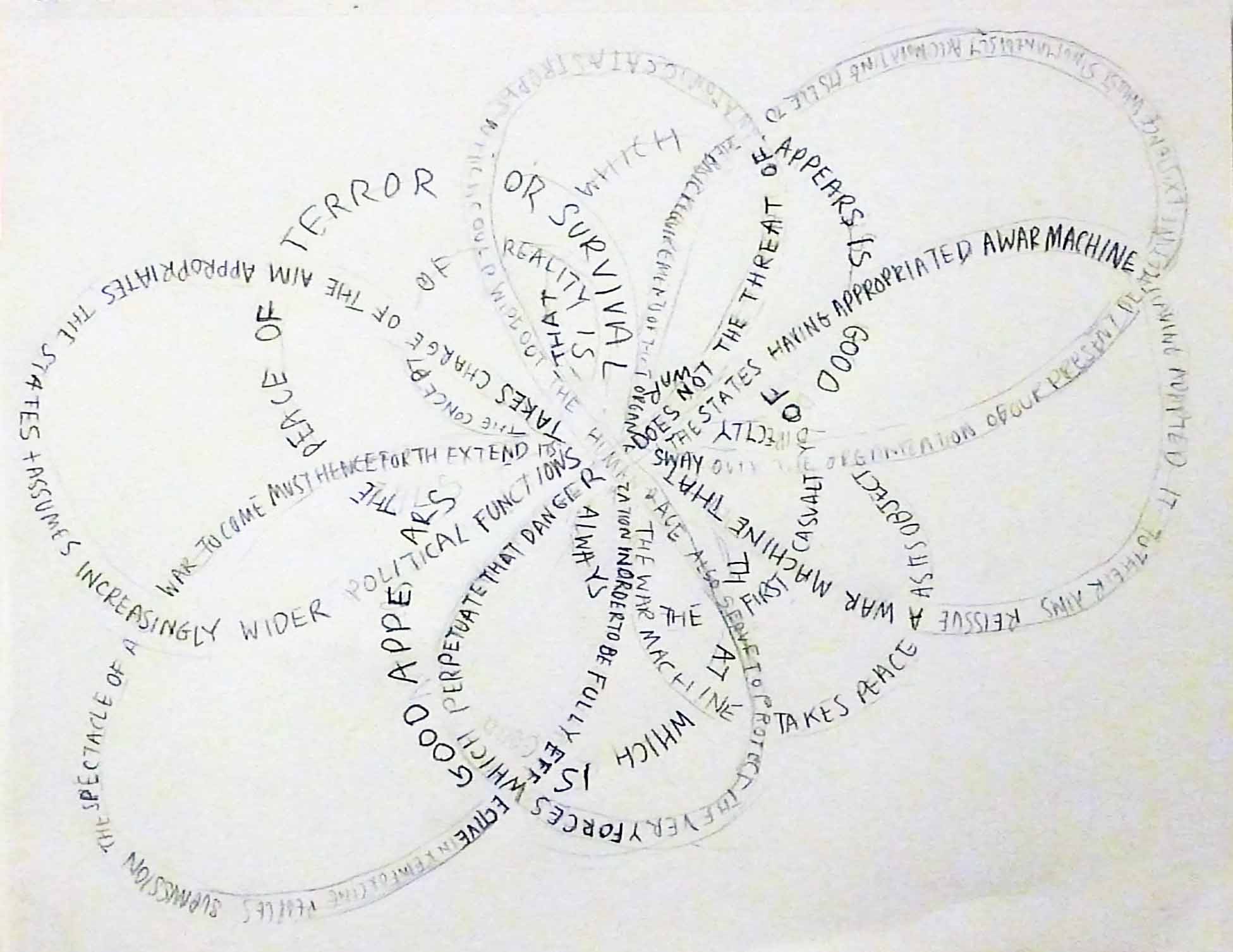
'This is Tomorrow' (with audio) will premiere at Blinc Festival 22/10/11
15/10/11
Putting final touches to the next release. A 7:30 CD single of the electroacoustic work done for Helen and Rhys' installation. 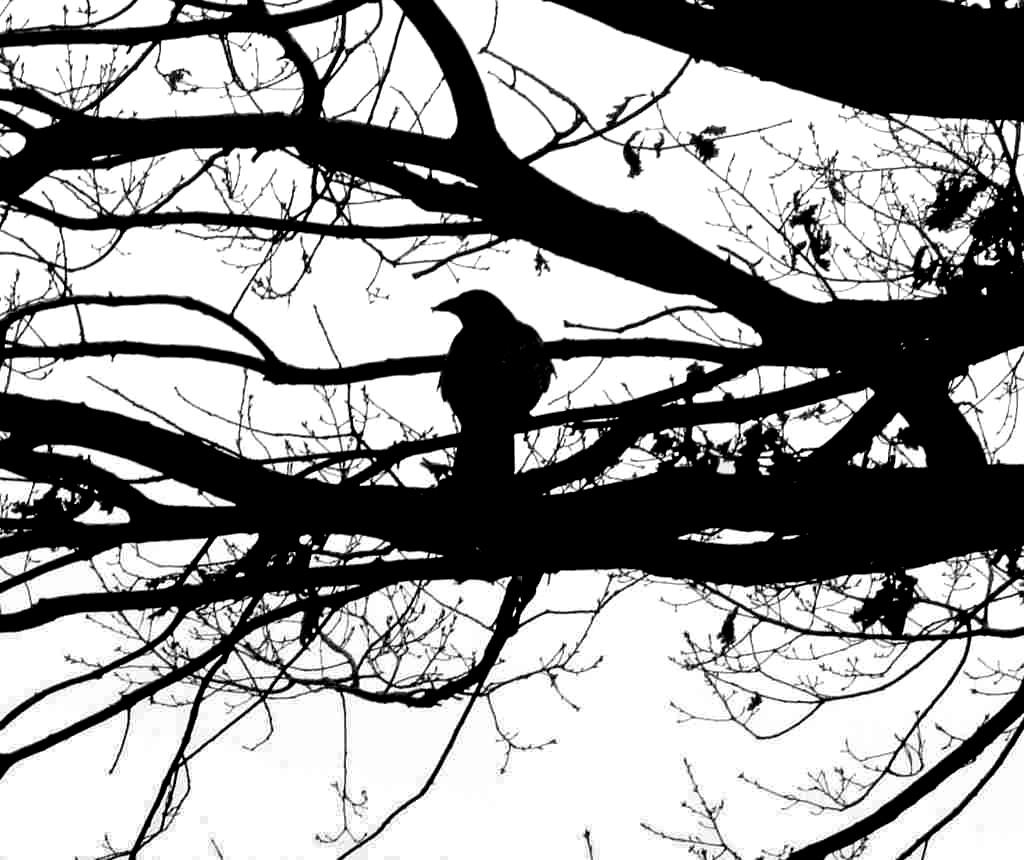
JACKDAWS - Ed Wright Release date 22/10/11 BLIP006
For the amazing price of £1.00!!! Available on CD (and download soon)
13/10/11
Stuff for the 3 Blinc commissions is completed *sigh* now gearing up for Risk of Shock on the Friday and Blinc on Saturday/Sun. z z z z z z
9/10/11
A wonderful photo montage put together by Tim of the work that he and Wendy have been doing on the Amser ("Time" in Welsh) stop motion animation. I've just completed the audio for it and it's going to be projected on the side of Conwy Castle as part of the Blinc digital arts festival later this month. :)
Photo courtesy of Tim's facebook page!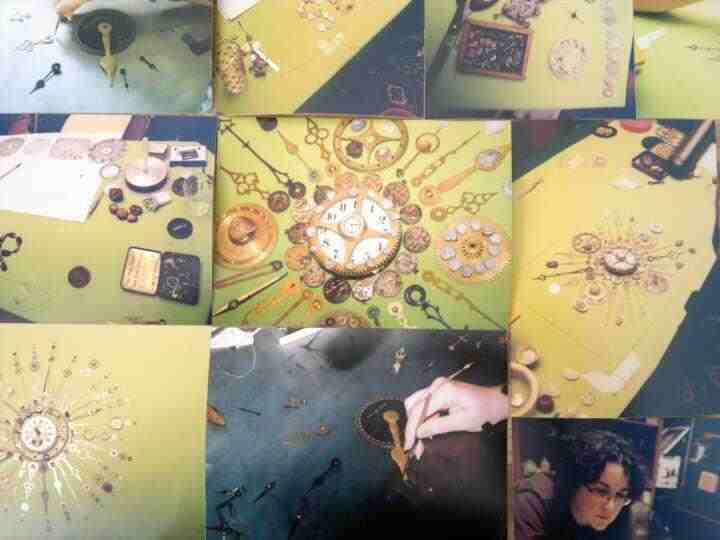
2/10/11
Photo from the Good Robot 'Interplay Room', complete with sofa and 'Sound Games' on a big screen (along with 'Hopscotch') for people to come and tinker with :) I was honoured to share the room with Mike Cook and Zac De Santos and their wonderful invertions...
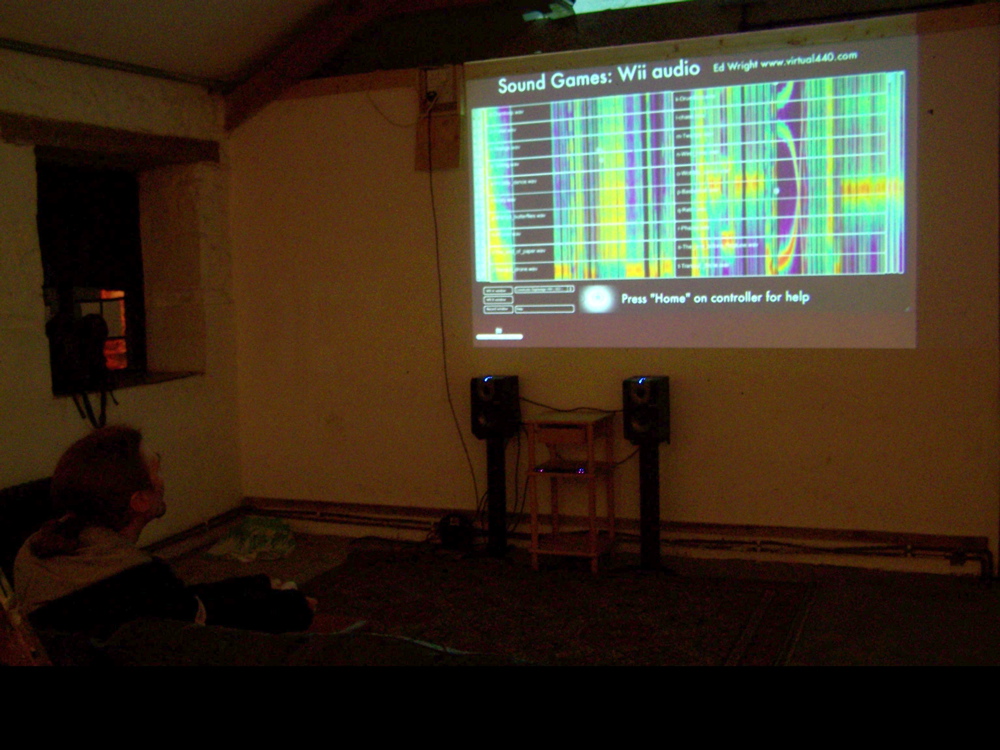
25/9/11
I've decided I actually quite like collaborating. I’m currently working on a piece with Dominic McGill for Blinc Festival (also as Tim and Wendy haven’t finished their stop motion animation yet it seemed sensible to get on with something. Anyway, here is a photo of Dominic’s piece: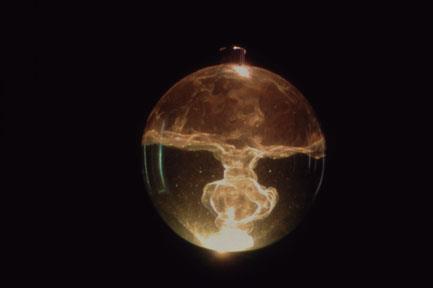
‘This is Tomorrow’ by Dominic McGill
It’s great the way that working with other people forces you into new ways of doing things. Use Hachiya’s ‘Hiroshima Diary’ as the basis for a sonic morbius loop…. Hmmm, yep this can be done, and I’m now in love with ProTools elastic audio for speeding things up and down to boot!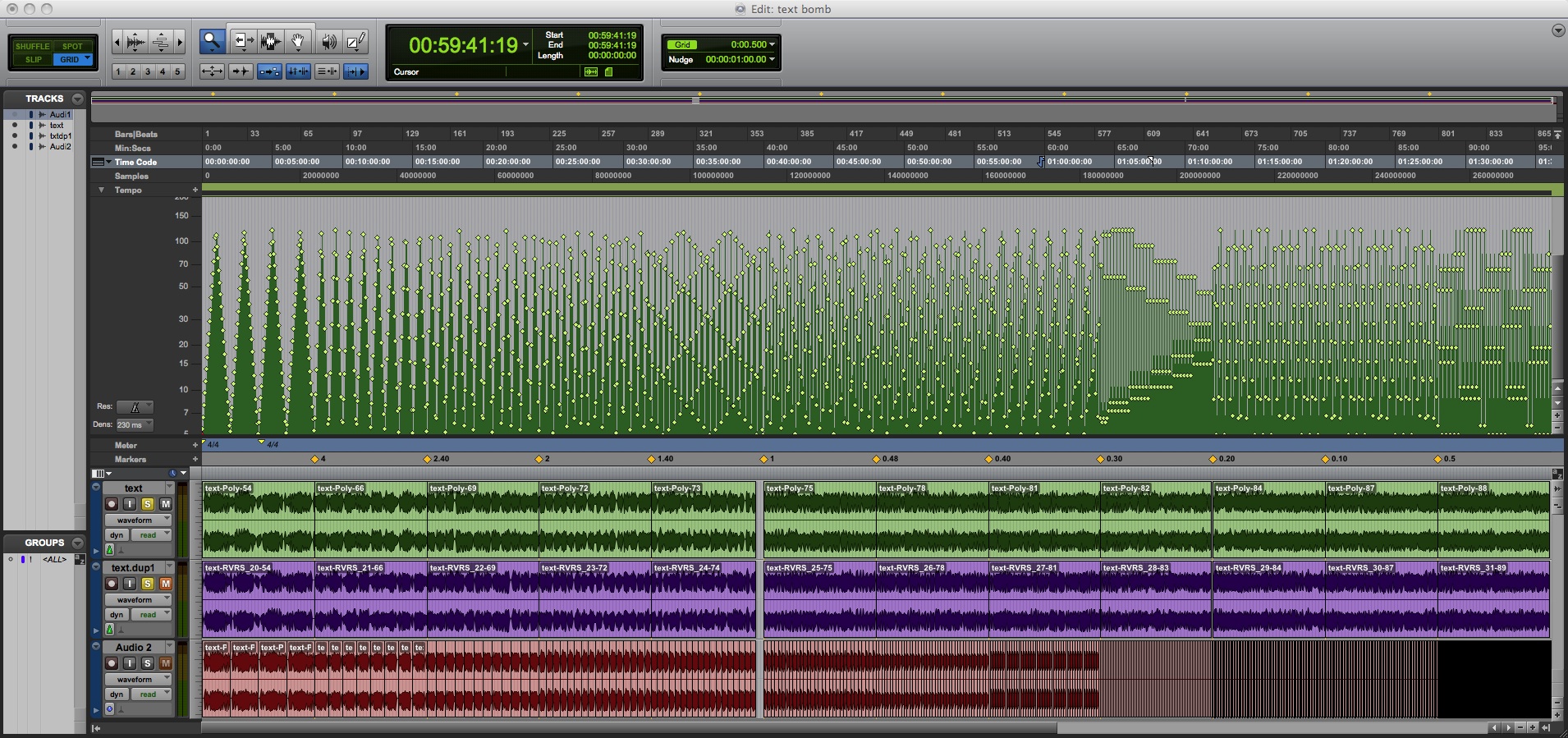
19/9/11
In Bangor University's Studio 2 setting up to do some recording with Tim Pugh and Wendy Dawson. We are collaborating on stuff for the Blinc Festival next month. Recording some very quiet ticking clocks. Having got in early to set up, I'm now ready and bored, happily reflecting on the fact that whilst ideas and talent are absolute essentials; a sound proof room, 96kHz sampling rate and a matched pair of Shoeps microphones will hopefully help a lot too!
A few mins later and here we are a nice analogue clock, probably rendered completely rubbish by mp3-if-ication, but it was lovely and clear to start with, and also quite nicely irregular if you listen long enough!
Strangely it's quite nice to be back in the place, I'll also (apparently) be doing work for the festival with Dominic McGill & Helen Booth.... Busy busy busy!
12/9/11
Sound Games Ed Wright 2011
Structured improvisation for computer and Wii controllers
Sound Games is an improvisational/compositional environment (programming EW). At its heart lies the idea of gesture as fundamental to our understanding of music. This functions on a number of levels; firstly there is the innate physicality of playing an instrument, banging a drum harder to make a louder sound or breathing in to prepare to sing. At the other end of the process there is the aesthetic recognition of the gestural properties of a piece of music, as exemplified in the phrases ‘a descending tune’ or a ‘swirling cacophony’.
Computers have very simple methods of communicating with the outside world. On an average PC one tends to find a keyboard and a mouse as ways of entering information. Whilst this is perfectly acceptable in most cases it does little to reflect or for that matter enhance the music making process, indeed it is almost the digital equivalent of trying to make music with a pencil and paper or various pieces of office hardware!
Sound Games is an attempt to break down some of these barriers.
The program uses two Wii remotes, one to control the left half of the screen and one to control the right. Each long white rectangle represents a sound file indicated by the name e.g. . The position of the cursor with that box (controlled by the remote) dictates the pitch and left/right positioning of the audio, in a hopefully intuitive, left makes it go left, up makes it go higher fashion. In addition to this rotating the controller inwards makes the sound louder (conversely outwards lower), the ‘A’ button locks the cursor to the current vertical position, the ‘down’ button disables pitch shifting and the ‘B’ trigger starts or stops overall playback.
It is an inherently simple instrument, but a lot more expressive than a QWERTY keyboard. If one then sets the tolerances fairly fine it becomes harder to control but with a far greater range of expression, you can do more things and in so doing the potential for doing ‘wrong’ things is also increased. It is exciting to find a way of creating music with a computer that requires similar levels of practice and motor coordination as you would expect on an acoustic instrument.
8/9/11
Working all day and then set up for "Live Study" (see score below in 4/9/11) until 10pm :&
It's shaping up to be a lovely environment to be in, come along on the 9th it should be ace and it's free entry!
5/9/11
Now showing in exhibition at Penmaenan community centre.
Folksong: Ed Wright, 2011
(Soundsculpture from found object, fishing line and piezo transducer)
Folksong is the re-imagining of an old framework. Retaining its innate structure it draws from other resources in its surroundings and incorporates new ideas and materials into itself....
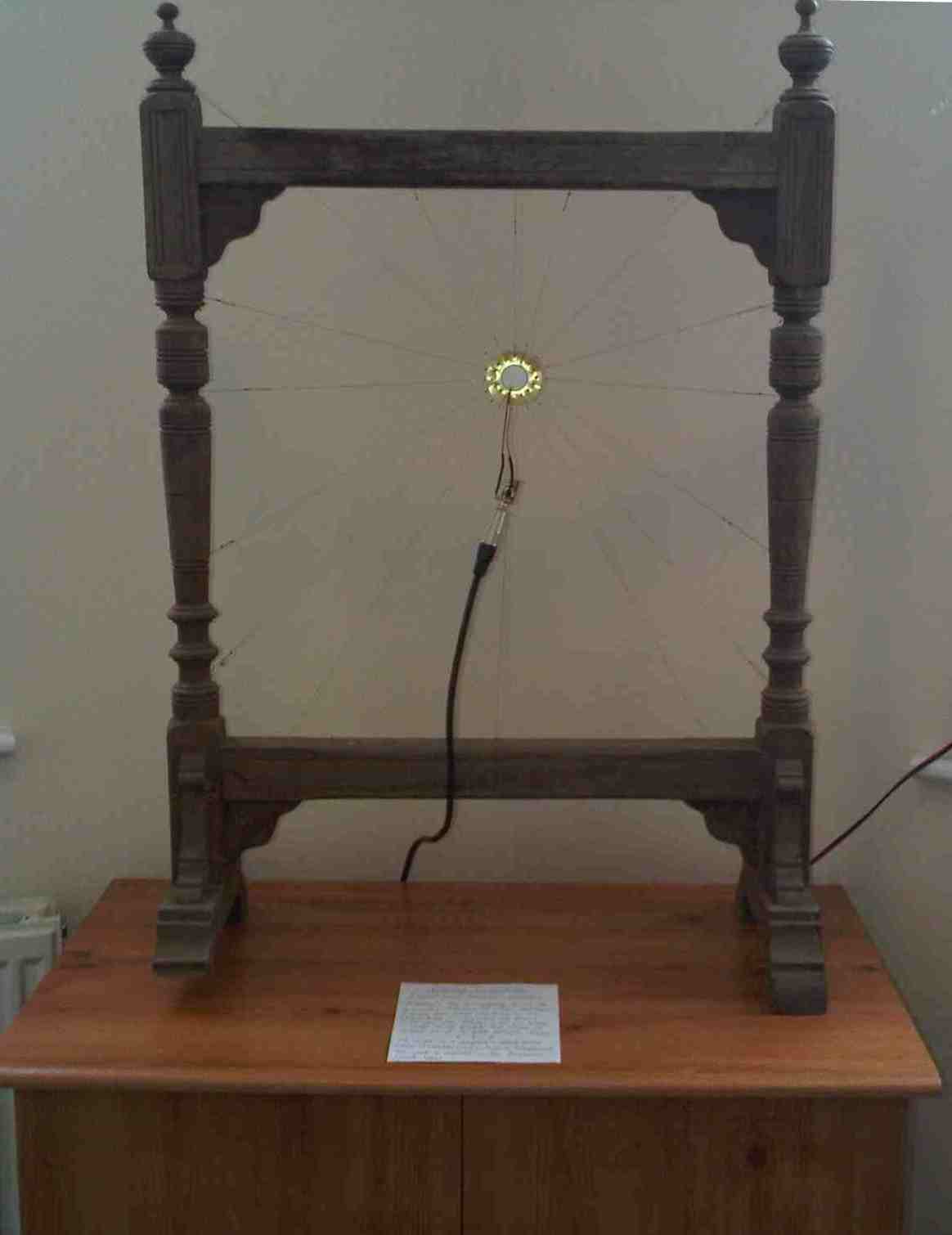
P.S. This hopefully starts to make sense of some of the ideas from the 1/8/11 and 15/7/11 (see below)... I'm working on a massive 3D version of this idea, a cube made out of 15mm steel, roughly 2m x 2m x 2m a similar idea with the fishing line and piezo mics but extending from the edges, less regular and big enough for people to easily get inside and move around in.....
4/9/11
To be premiered on Friday....
|
LIVE STUDY: Ed Wright 2011
Performance Score
|
3/9/11
Doing this today!

www.helfagelf.org
30/8/11
Making noise and visual stuff in Llanfairfechan this morning, and helping to set up an exhibition in the Penmaenan community centre this afternoon as part of Helfa Gelf. Helfa Gelf is a series of events taking place across N. Wales through September. The idea is to have artists working in their studios but to have the studios open to members of the public to pop in and visit (kind of like a friendly cultural zoo!) There are also a number of exhibitions running such as the Penmaenan one (opening times at www.blipfonica.com). My studio will be open weekends in September from 11-4 and I'll be performing as part of the general festivities on 9th Sept in the Penmaenan Centre and on 16th in Y Galeri Caernarfon.
16/8/11
Rain again today! I guess that is what I get for living by the sea. So no work going ahead on the steel sculpture work as it has to be done outside (owing to the fact I'm trying not to go to the studio over the holiday and it won't fit in the living room). However, with sidelines on sidelines going on, work is therefore progressing on a Magnificat and Nunc Dimits based around the base sequence of the chromosome of bateriophage phiX174 (the first complete mapped genome). On first inspection the code appears rather unpromising
gagttttatc gcttccatga cgcagaagtt aacactttcg gatatttctg atgagtcgaa...
I've re-mapped the sequence to span an octave and imply rhythmic duration, and, oddly with a little bit of tweaking the system it comes out with some unexpectedly beautiful results. The table can be read like any ordinary table. Along the top is the genome 'letter' and down the side is how many times it comes in succession eg. aaaaaa would relate to A x 6.
| A | C | G | T | |
| 1 | D | A# | G | D# |
| 2 | C | B | E | F |
| 3 | A# | C | C# | G |
| 4 | G# | D | A | G# |
| 5 | F# | F | A | |
| 6 | E | B | ||
| 7 | C# |
According to the table this would result in the note E being sounded. Duration is also mapped by the number of repetitions although a lot more simply, the above Ax6 example would mean that note would last six quavers Tx3 for the quavers and so on. This gives us:
the original opening of the string:
gagttttatcgcttccatgacgcagaagttaa…
the string is the re-transcribed to show individual ‘events’:
g a g tttt a t c g c tt cc a t g a c g c a g aa g tt aa…
the letter and repetition data is then mapped and transformed as per the grid above giving:
G1 D1 G1 G#4 D1 D#1 A#1 G1 A#1 F2 B2 D1 D#1 G1 D1 A#1 G1 A#1 D1 G1 C2 G1 F2 C2…
This can be then translated into standard notation by simply taking the letter and # to indicate pitch and the number to signify the duration in units of a quaver.
Philosophically and ideologically I'm quite excited by the idea of combining the word setting and the DNA form. There feels as if there is something a bit subversive and yet also praising about the idea, a tug of war between evolutionary chemistry and the work of divine precision and creation. I can't quite put my finger on it but working the piece out feels like it may be one amazing ride!
4/8/11
Thanks for all the birthday wishes!
1/8/11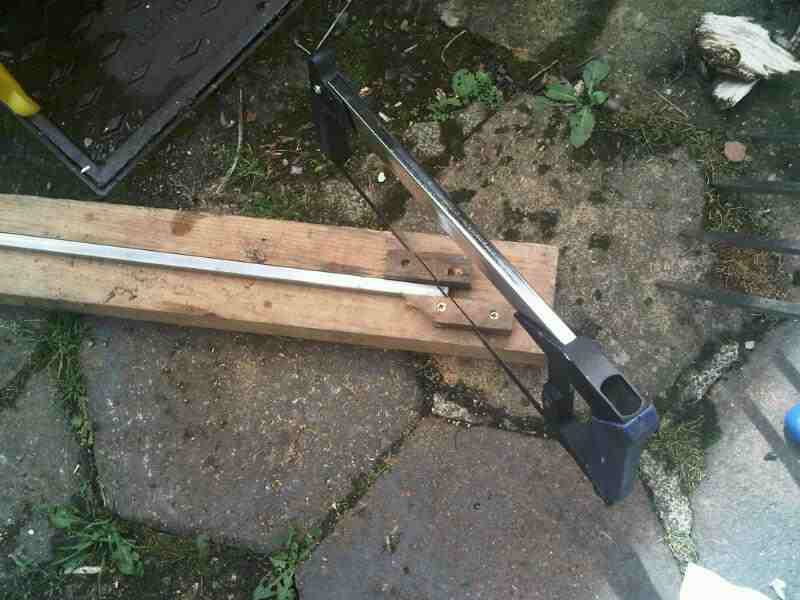
August is here, which means an attempt at a holiday. So I'm kind of 'not doing music' but am chopping up lengths of steel (in a very occasional manner) to build into a sound installation/sculpture. As it's closer to the role of blacksmith than "Musician" I feel it's not really cheating....
28/7/11
As a result of a 3 day masterclass/workshop on Sound Art with Manuel Rocha Iturbide, this is my contribution: collaboration with Andrew Hodges, Scott Flesher and Alistair Attard for Bangor Cathedral.
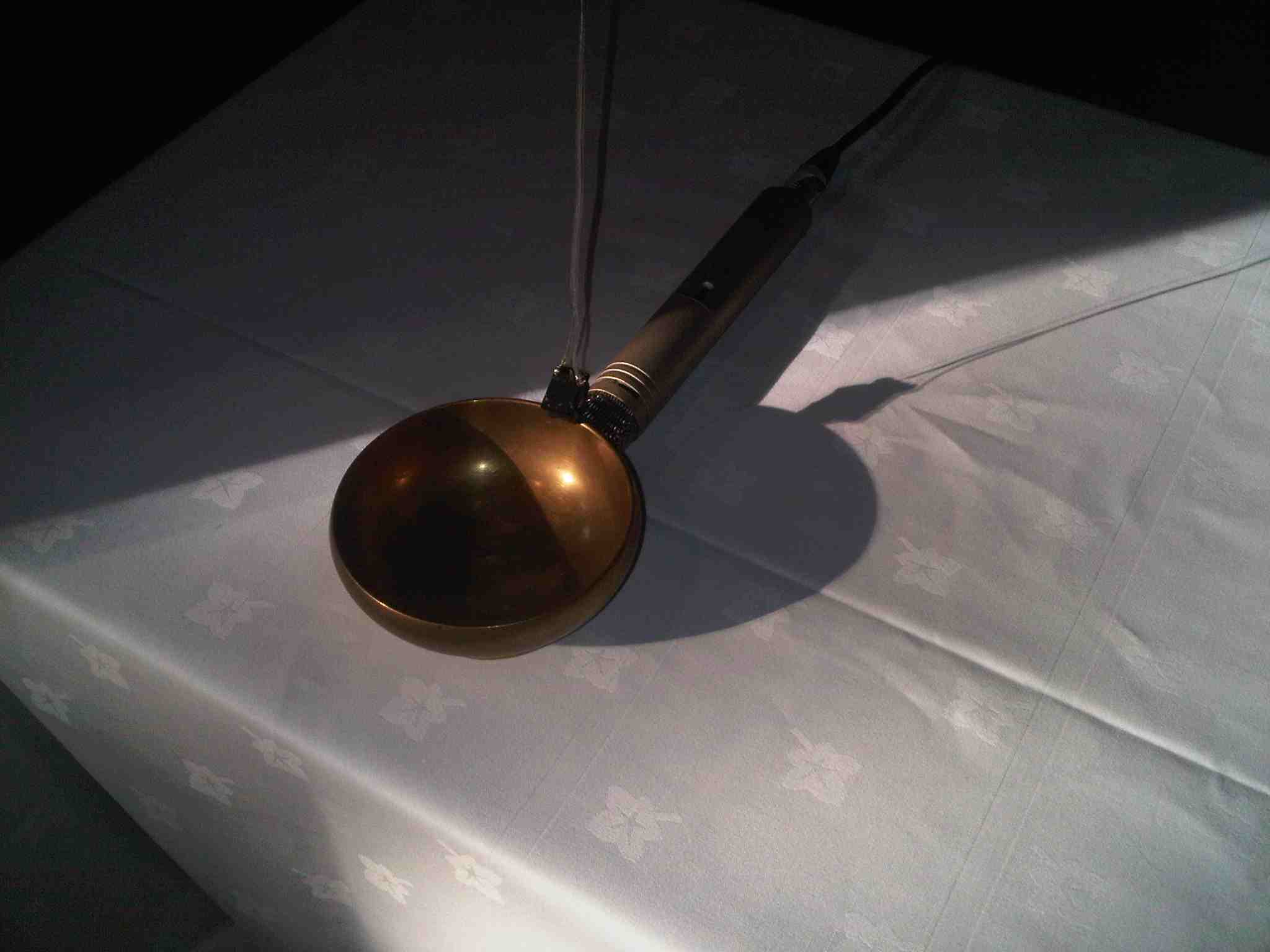
It's called 'Wordless Prayer' and uses a simple relay driven from an Arduino board (click here to view CODE) to make a prayer bowl vibrate, which is in turn fed to a microphone and reverberates and feeds back through the space of the cathedral. It resonates the rhythm of the Lord's Prayer, which oddly enough seems to have approximately the same intonation and syllable structure whatever language it is in.
Being pretty site-specific and conceptual I probably haven't done it much credit here, so come along and see it in Bangor Cathedral 27-30th July 2011 (free entry). It's running all the time except when services are happening. There is a 2 min pause in the loop so if you pop your head around the door on a trip through the city and nothing seems to be happening, please come in, pause and reflect, it probably is running!
25/7/11
On a three day Sound Art master class the Manuel Rocha Iturbide courtesy of Bangor Sound City. Nice!
23/7/11
On an aside...
Following on from an initial rush of excitement and inspiration at BEAM festival about a month ago I've been playing around with learning a bit more about the electronics side of electronic music. It's odd that most people just assume that any decent musician must know how to (if not repair, at least) maintain their instrument in good working order but that this somehow does not apply to those working in the field of electronic music. Anyway, to cut a long story short I'm trying to fill in a few gaps in my knowledge as well as experimenting (in a very basic and amateur fashion) with an Arduino board (pictured above with breadboard and LEDs) and attempting to learn 'stuff' that will be of use in the long run for making music, performance interfaces and installation mechanisms. Or at least that's the plan. At the minute I have 3 happy flashy lights, an approximate idea of how to code for an Arduino and a big chart with resistor colours on it. Any advice or tips to the usual email would be great! Thanks Ed
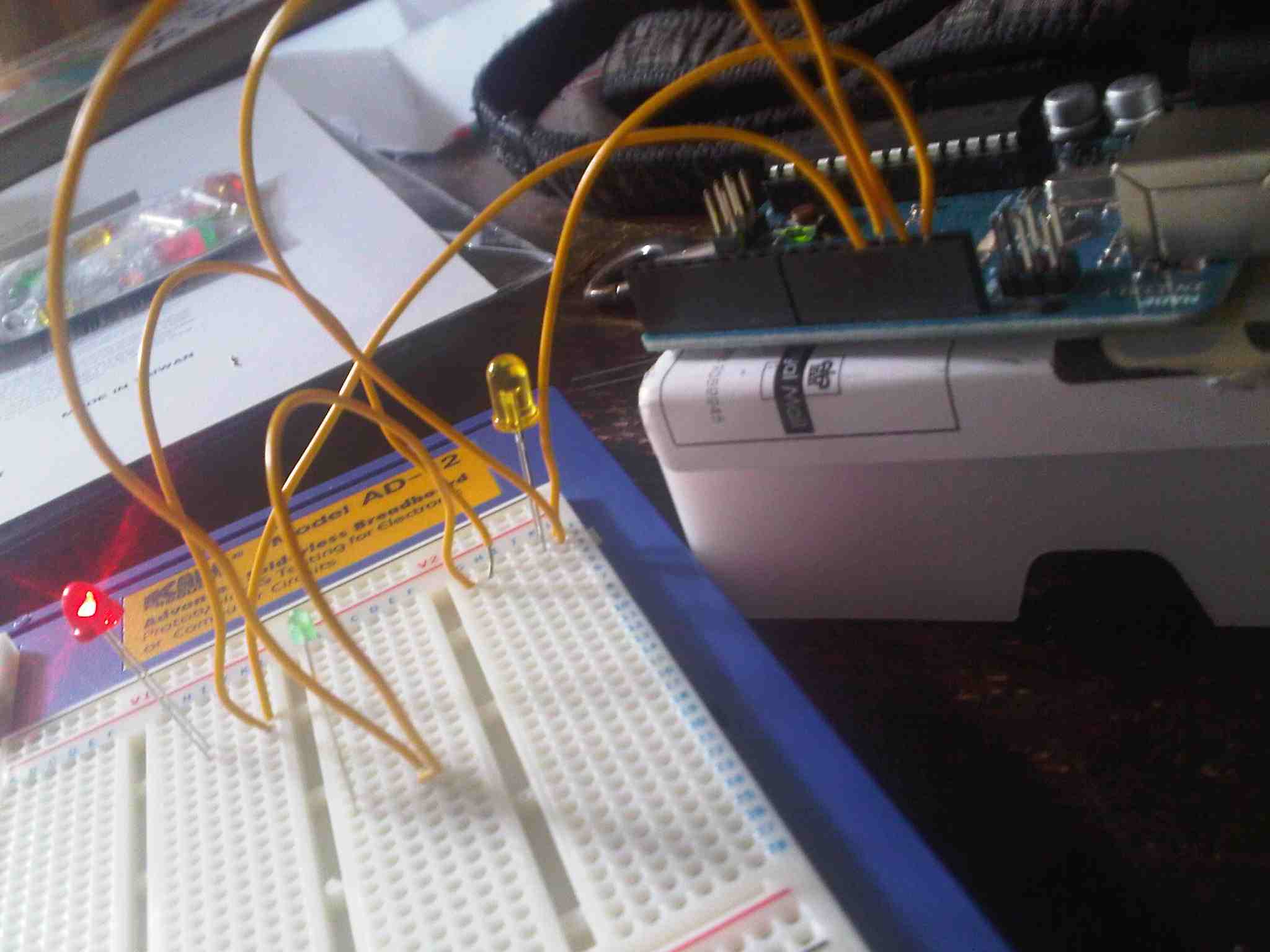
20/7/11
Steel for installation update! :)
I've got some now, courtesy of Williams the Steel Fabricators in Llandudno. Let battle commence! Thank you all.
18/7/11
Working on developing software to blur the edges a bit and make live performance more 'live'.... Currently it's a step sequencer but watch this space.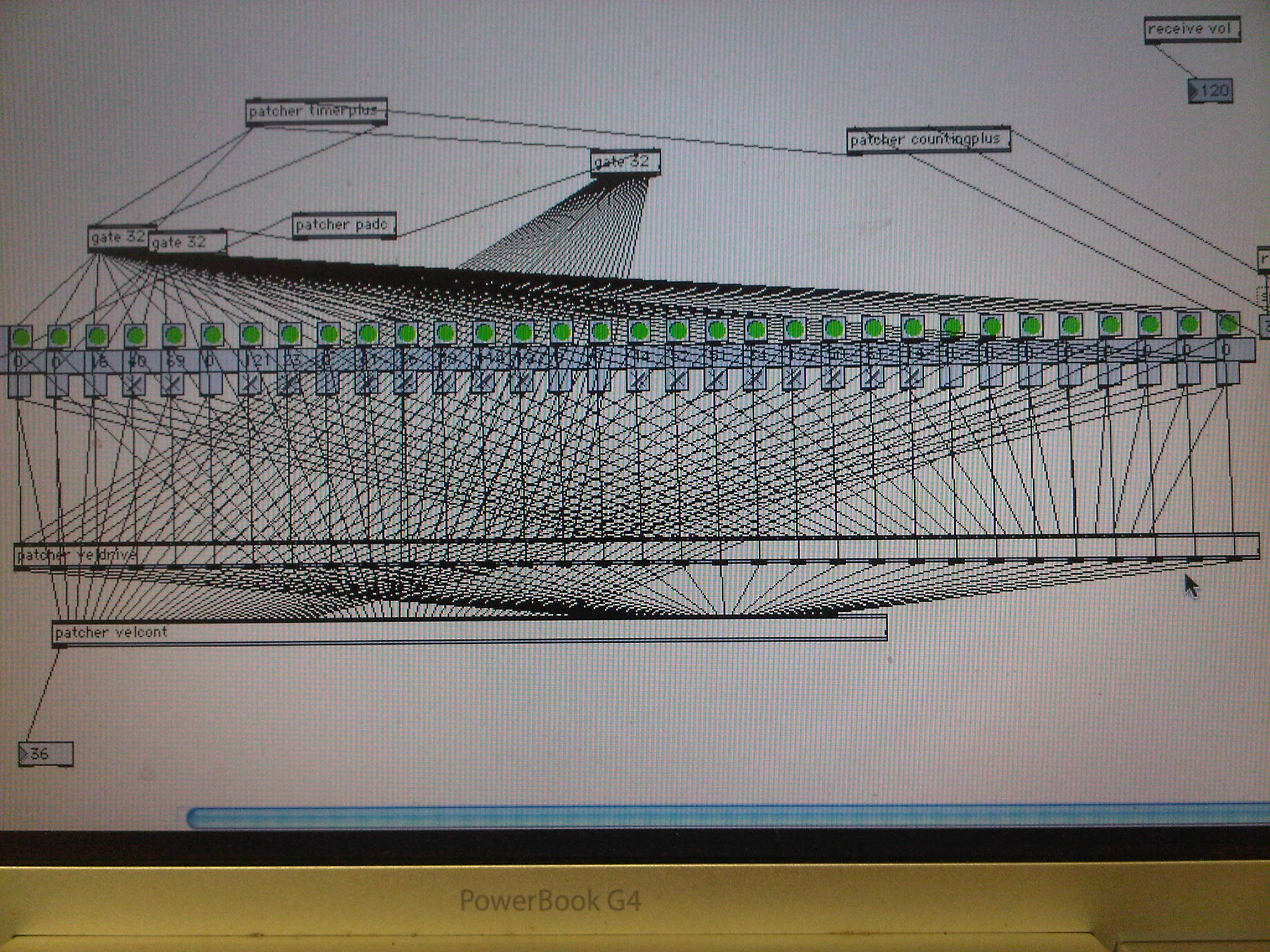
15/7/11
Starting work on a new piece.... Does anyone know where I can get 10 x 2m lengths of box steel tubing from?!
14/7/11
Recovering, tiding studio, drinking tea and reading Douglas R Hofstadter's Gödel, Escher, Bach: An Eternal Golden Braid
11/7/11
Not strictly a creative endeavour but graduation from PhD in music. Big thank you my supervisor Andy Lewis for all his help and support!
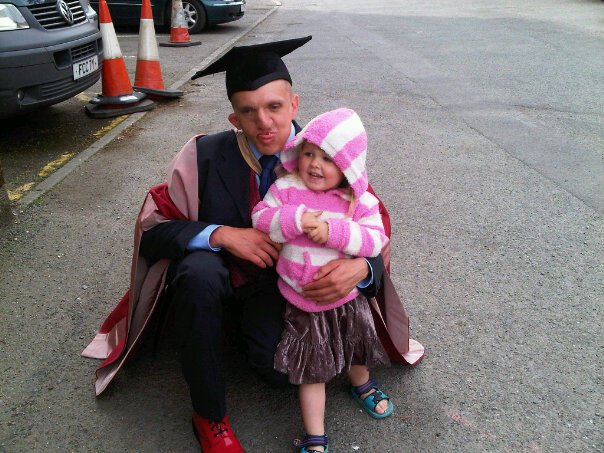
10/7/11

